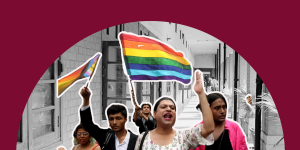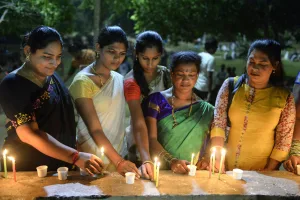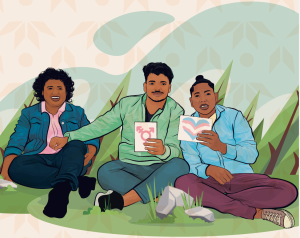Long shadows in the sunset
With limited support structures, India’s LGBTQIA+ community has to work harder to plan for ageing and infirmity
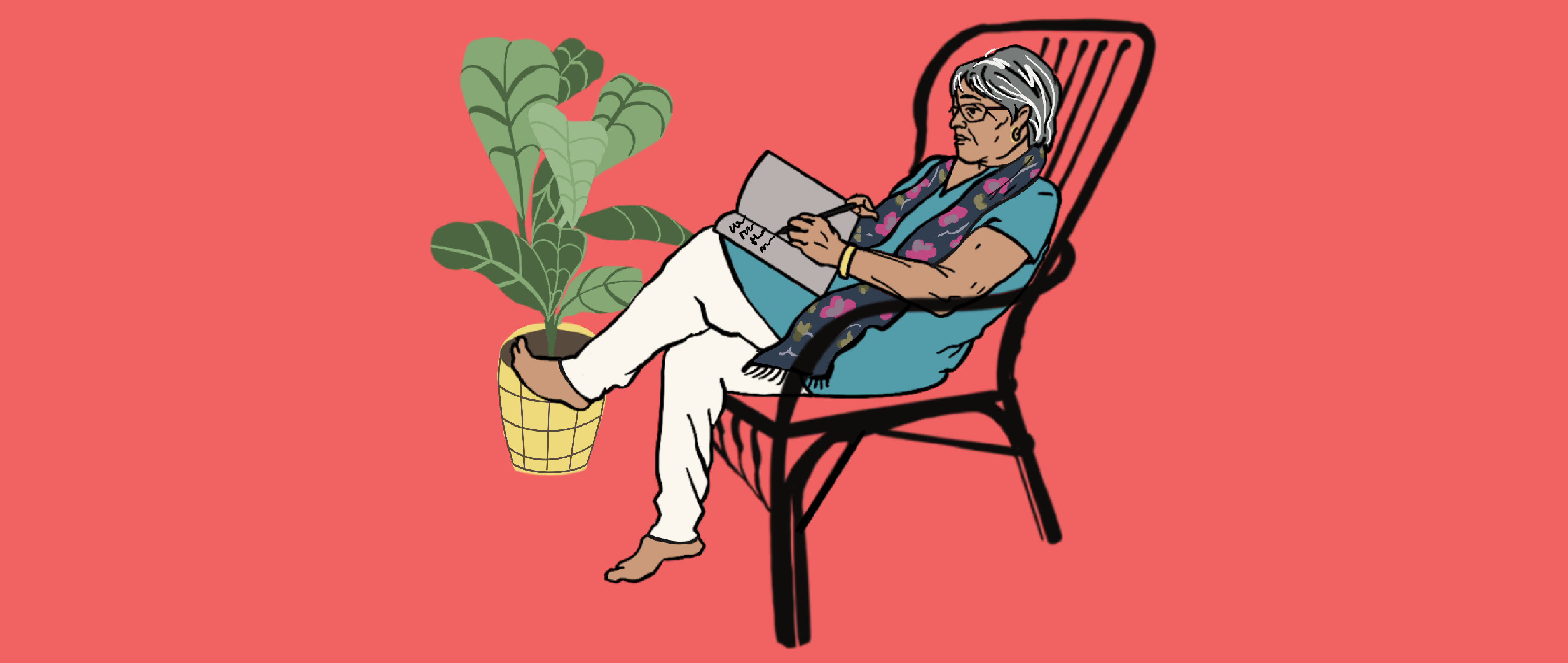
This story was supported by the Pulitzer Center
Maya Sharma, a gender rights activist and writer, visited many old age homes in Gujarat and New Delhi but did not find one that suits her needs. Some were not clean enough, others were too expensive or expected residents to follow religious rituals. But the biggest hurdle was that none of them felt safe enough to let her live her life as a queer person.
Now 71 years old, Maya has been thinking of moving to an old age home for more than five years. Since 2020, her search has become more urgent, hastened by some experiences during the pandemic—when she and her partner shivered with high fevers due to COVID-19, when she slipped in her bathroom and bruised her foot, and when she could not recall the names of close friends she met after a of couple years. The lapse of memory was “embarrassing,” Maya told me.
Although Maya currently lives with her partner in Vadodara, she anticipates spending later years of her life by herself in an old age home. For her this would be a place that can care for her, where she can read and write quietly, and where she does not have to hide her queer identity. So far, this idyll exists only in her imagination. She has found no place which would “validate us,” she told me.
Maya’s siblings are scattered across the world, and her son from an earlier marriage lives in Delhi. Maya knows that these family members will take care of her but she is reluctant to be a burden on them. Moreover, she does not feel comfortable returning to heterosexual systems of living. She thinks that these systems may still not accept her and might be too rigid for her to be and express herself. “I chose a different path earlier on,” she said. In the 90s, Maya walked out of her marriage with a cis-man in Rajasthan. She described the marriage as “cloistered and closeted.” She turned to the women’s movement to find her community and a little later fell in love with a woman.
Queer persons who leave or are forced out of their parental homes at an early age, or walk out of non-queer marriages, leave behind the conventional support systems. Their lives can become more uncertain when it comes to forming relationships and finding communities that will last into sunset years.
Maya said that just being queer could sometimes limit their support options as they plan their future. “Jo heterosexual log hain, unke liye aisa deewar hai jo woh pakad ke khade ho sakte hai. Bahut thos hai, bahut nazar mein aati hai. Humare jo saharein hain woh thos nahi hai.” (Heterosexual people have some sort of a visible support system around them, like a solid wall, which they can hold on to. Our support systems are not as sturdy.)
I spoke to many queer people, most of whom were 50-years-old or above. Many of them said that anxiety about personal and institutional support structures, failing health, shrinking livelihood options, imminent loneliness and the feeling of being invisible in India’s LGBTQIA+ community, largely perceived as young, were some of their common concerns about aging in the country.
In 2020, a study was published on the mental health of middle-aged and older queer men in India. The study is an outlier in academic research. Social science research about queer people in India is rare and older queer persons remain underrepresented in this small universe. The study said that more than 60% of the participants reported feeling lonely. “A feeling of alienation, particularly from the heterosexual universe, was very common,” the study stated.
That feeling of alienation can persist in old age homes as well. These institutions tend to follow culturally normative societal standards, said Raj Mariwala, director of Mariwala Health Initiative in Mumbai, which provides accessible mental health services to marginalised communities including LGBTQIA+ persons. This default mode of operation forces some queer persons to grapple with questions that heterosexual people would not have to ask themselves. Can they access these homes based on their gender? Can they live there with their partner? Can they expect privacy? Can trans women access cis-women’s shelters? “A shelter home can itself be a hostile space,” Raj said.
Sometimes this hostility takes the form of probing questions. In 2015, the organisation LABIA—short for Lesbians and Bisexuals in Action, a collective of lesbians, bisexuals and trans men—published an anthology of stories called Labia Presents: Bees Saal Baad: Sangam Se Subversion Tak. One chapter narrates an uncomfortable interaction between two queer women in their 70s and the residents of an old age home they were considering moving into. The women wrote, “While screening us, they are most interested in how we are related to each other. So starts a barrage of questions.
Are you sisters? No.
So then you must be cousins? No.
Distant relatives? No, we are not related in any way, we are friends.
For how long have you been friends? Since a long time, we have been working together.
You must be living with your families? No.
Do you live close to each other? Exasperated, our curt reply comes — We live together — abruptly putting an end to the conversation.”
That single incident, they said, brought up all their anxieties related to the life they had chosen to live.
I spoke to a queer couple who moved into a senior citizen home run by a religious charity on the outskirts of Pune in 2016. They were in their mid-70s. One of the women, who asked to stay anonymous because the couple is not out to their families, told me that although they feel safe in the home, they are not prepared to reveal their sexuality. Residents and staff at the shelter home do not seem open to accepting queer couples, she said.
After joining the women’s movement, Maya became associated with Vikalp Women’s Group, a non-profit organisation that works in western India advocating for the rights of marginalised women and sexual minorities. She became its programme director, conducting workshops in rural Gujarat and Madhya Pradesh.
“You know I love my work,” she energetically declared once while on a phone call with me. She would sometimes be in the middle of her workshops when I called her. I would see her on Zoom, sitting on the threshold of her house or her office. As she spoke to me, she would sometimes look away from the screen to smile at or speak to her younger colleagues, mostly trans men. She would flick her cropped white hair and laugh at how carefree they were and then would return to our conversation. On my computer screen, her eyes would sometimes appear slightly cloudy behind the iridescence of her glasses. Her voice would choke intermittently due to chronic asthma. “I am scared,” she said. “What if I get bedridden? Will I be taken care of?”
Ageing With Disability
Rajib Chocroborty spoke in a hushed voice as I sat in his living room with its walls in shades of pistachio green, strawberry pink and butterscotch yellow. Rajib lived with his mother in Baruipur, a semi-urban locality on the outskirts of southern Kolkata. He did not want her to catch her 53-year-old gay son discussing his sexuality with me, an outsider.
As we spoke, he would sometimes push his hands down, hoist himself up from the plastic chair he was sitting in, and squeeze his eyes shut as he sat back down. His legs are weak due to an accident in 2004. He uses crutches or the support of walls to walk around the house.
Rajib’s siblings live far away, in other states. His mother, Uma Chakraborty, who is 77-years-old, has been looking after him for 18 years since the accident. Uma prepares the bathroom for him every morning, cooks all his meals, and assembles an ice compress to soothe the ulcers on his legs. She does all this though age has hunched her back and slowed her movements. By the end of the day, her body is exhausted but her mind stays occupied with thoughts about Rajib’s future.
“My worries are like a mountain,” Uma said in barely audible Bengali. Rajib, who translated for me, chuckled but Uma continued. “Who will look after him? Who will take care of him?”. Although Rajib laughed as Uma spoke, the questions she raised sometimes haunt him, more so as he gets older. For now, Rajib’s biggest immediate concern is his and Uma’s growing dependency on others. He plans to hire a caregiver soon.
Rajib has never had a romantic partner. This is partly because of his disability, which limits his movement and social interactions. Living in Baruipur, away from the city life, further restricts his access to the queer community. Some of that, over the years, has lessened Rajib’s desire for intimacy and companionship. He has started to wonder whether he identifies as an asexual person. “Everyone has to accept their circumstances,” he told me. “There is a chance that if I did not have this accident I would have had a different life. I lost that chance. I know it’s not going to be easy, but I don’t feel the urge to be with someone now. I am satisfied with what I have.”
Rajib spends part of his day as a teacher in a nearby school where he hides his sexuality, and ignores his colleagues’ homophobic jokes. He fears being outed and consequently losing his job. He spends his days after work at home writing poems about being closeted, falling in and out of love, and coming to terms with his androgynous voice. Sometimes he watches gay flicks and his recent favourite was Heartstopper –a popular queer drama on Netflix. “It’s nice to see the young free love,” he said.
Rajib’s few queer friends live in Kolkata city and he meets them only once or twice a year. He is part of a small queer group on WhatsApp where members share videos or news about the LGBTQIA+ community, wish each other birthdays, and sometimes “crack queer jokes that straight people won’t appreciate”, he said, laughing.
Occasionally, he interacts with a bigger queer group on Facebook. But, he does not have a close queer friend whom he can just call to talk. He said that he does not mind his solitary life but what would really make it happier was if he could have “dependable and trustworthy” queer persons to help him with physical tasks and share some of his day and his life. Rajib feels that there is little conversation about elderly queer people, especially those who are also disabled, outside and within the community.
Dhrubajyoti Bhattacharjee, a 46-year-old gay man living in Delhi, echoed this feeling. He has limited vision because of glaucoma. “We don’t know what challenges disabled queer people who are aging face. How do they face them? What do they need?” he said. “Our needs might be very specific but really nobody even bothers to ask.”
Besides failing health and loneliness, Dhrubajyoti worried that queer people his age or older may lack financial security. His partner mostly depends on him for finances. They have been to multiple banks to open a joint account as partners so they can both access their combined savings. But they were told that the proof of family relationship is a prerequisite. “It’s all bullshit that certain banks accept LGBT partnerships. They don’t,” Dhrubajyoti said. “I worry how my partner will survive if something happens to me.”
He remarked that unless institutional support structures were created for LGBTQIA+ persons, especially those older and vulnerable, they would continue to live with a sense of insecurity.
A Graying Minority
Fifty-year-old Sanjana Guru, a transgender woman and a resident of Pune, panhandles to make a living. She used to go out every day to beg at shops and would occasionally dance at weddings. In the last three years, she has had to reduce the number of times she goes out from every day to twice a week, hampered by severe pain in her hips. She has not danced at a wedding in five years.
Sanjana lives alone in a small room with minimal furniture in a Pune slum. When we met on a sunny afternoon in September 2022, she walked slowly and with a limp. Her hip joints have degenerated, partly as a side-effect of the drugs she takes to manage her HIV infection.
Sanjana gets a regular income of Rs 3,000 every month for social work in her neighbourhood. This covers only part of her expenses—groceries, a gas cylinder and medicines. She has been putting off the hip replacement surgery she urgently needs. The surgery costs about Rs 1.75 lakh and would keep her in bed for about three months. She does not have that kind of money or time off her feet. Accessing affordable healthcare is a challenge for many trans persons, especially as their income sources dwindle with age. “I have just been depressed for the last three years thinking about this,” she said. “I need to walk and dance to earn.”
Sanjana’s birth family have not been in contact with her since she left home in Pune at the age of 23. She has had two relationships with cis-men but neither lasted. Sanjana has some trans friends in the slum who care for her but nobody close enough who could stay many nights by her side in a hospital. They are also hustling every day to earn their livelihood. As we were talking, her neighbour, an elderly woman, walked in. She asked Sanjana about her health, and they started chatting about their and others’ lives in the slum.
The pandemic made many transgender persons, especially older ones like Sanjana, even more vulnerable as curbs and lockdowns restricted their modes of income. A study published in 2021 stated that older transgender people were a “graying minority” at increased social and emotional risks, many of them facing the “dual burden” of age and gender.
I met a 55-year-old civil engineer in Hyderabad for whom growing old meant having less time to come out. She went by a male name with her family, including her wife and parents, and with the world at large. But with her trans friends whom she trusted with her gender identity as a trans woman, she adopted the name Julie Jennifer. She has given herself two more years to leave her marriage, after which she wants to spend more time with her trans friends. “I need to satisfy my womanhood for a few years at least,” Julie told me.
At home Julie hides in masculine clothes. “It is suffocating but I cannot ditch someone I have married,” Julie said. “That is the only thing holding me back so far. Otherwise I would have left a long time ago.” Julie hopes that her parents and family accept her as she is. She wants to have a relationship with her parents and spend time with them for as long as possible. While she yearns to set herself free, she wonders who will be with her as she gets older.
Julie recently bought an apartment in her wife’s name to insure her wife’s future. But she still has to figure out where to go when she moves out and later, when she is too old to live alone. She is not aware of any institutional support for older trans persons. The government’s shelter homes or Garima Greh for trans persons excludes those who beg, do sex work or are above 60 years, ruling out the most elderly and vulnerable.
A Different Life Span
Gender and sexuality researchers increasingly say that LGBTQIA+ persons experience aging somewhat differently compared to cis-heterosexual people. The lives of LGBTQIA+ people do not follow neatly charted graphs with conventional milestones of getting married, having children or becoming grandparents, said Chayanika Shah, a 64-year-old queer woman in Mumbai who studies and teaches gender and sexuality. “Our life spans are so different.”
Svati Shah, associate professor of gender and sexuality studies at the University of Massachusetts, Amherst, said that this different life span impacts the support systems, responsibilities and concerns of queer people and even the age to which they get to live. “How many trans people do we know who did not even survive into their 30s because they took their lives?” asked Svati. Up to 31% of transgender persons in India die by suicide, and 50% attempt it at least once before their twentieth birthday, according to a 2016 study. The study noted that bullying, rejection by family and friends, violence, harassment by intimate partners, and social discrimination are some of the reasons, which could drive suicidal behaviour among transgender persons.
Within the LGBTQIA+ community, the experience of this life span including support systems changes based on peoples’ caste, class and gender. “What happens to those of us who chose to be single, whose disability is non-negotiable, or those whose body never got nourishment?” asked Vqueeram Aditya Sahai, a gender non-conforming writer and researcher at Ambedkar University, Delhi.
A common lament in the queer circles, Chayanika said, was that since there were so few older queer women, their lives and concerns have remained less understood and unaddressed. Most researchers I interviewed agreed that while there was a broad consensus that the LGBTQIA+ people experience old age somewhat differently, both in relation to each other and to cis-heterosexual people, society and academia lacked a deep understanding of what that actually meant.
Building Support
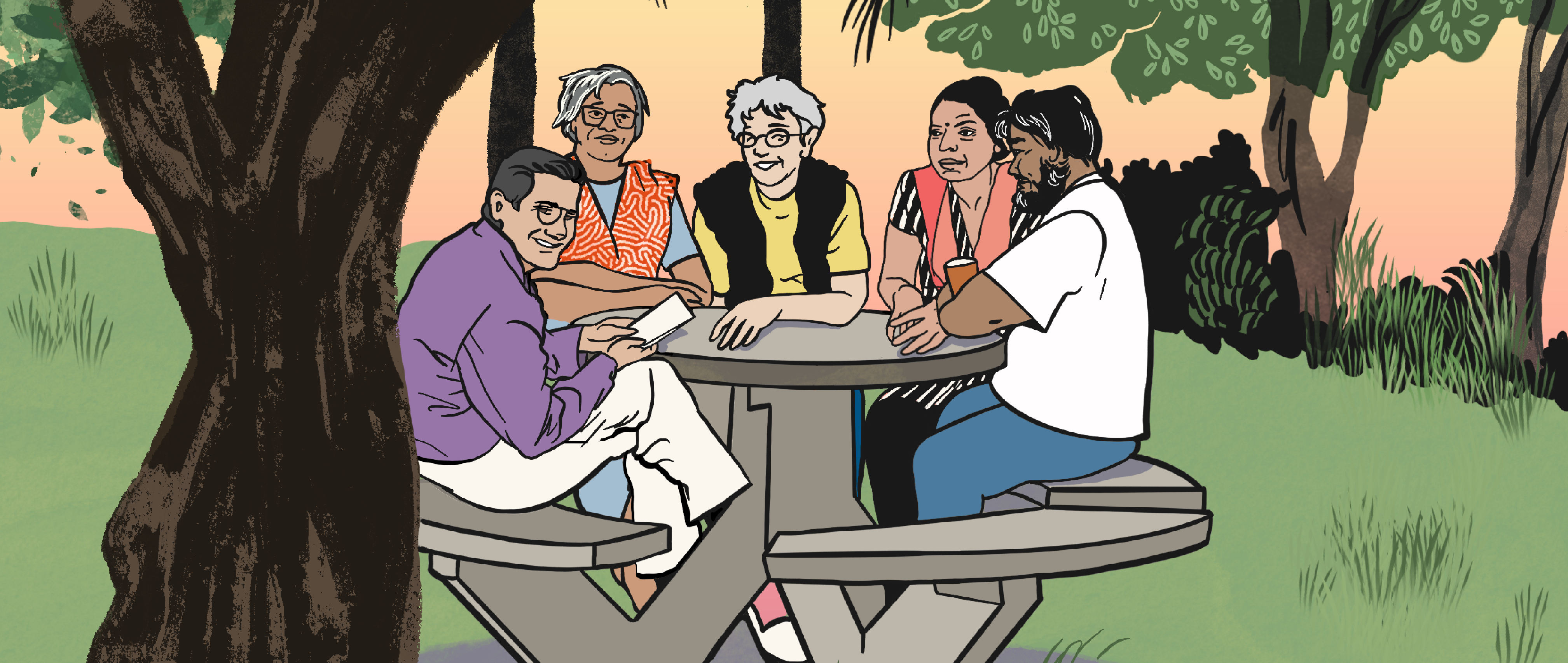
In the absence of traditional family support systems, some older LGBTQIA+ persons rely on chosen families, which may or may not include queer people. “My queer friends are my default support instead of family members, especially when I get sick and need urgent help,” said Pawan Dhall, a 54-year-old gay man who lives with his 90-year-old mother in Kolkata. Dhall is the founding trustee of Varta Trust, a non-profit organisation promoting dialogue on gender and sexuality in Kolkata.
During the pandemic, when Dhall fell sick, he called queer friends who found hospitals, arranged beds and oxygen cylinders, and got medicines. “It was really heartening,” he said. He believes that queers are most likely to show up for older queers. “They are also more likely to understand and empathise with our problems such as loss of a partner or loneliness, and relate to our stories,” he said. That is why Dhall is currently raising resources to build community support groups in Kolkata to care for the older members.
In 2017, gay activist Ashok Row Kavi and oncologist Prasad Dandekar started a support group called Seenagers. It pairs young gay volunteers with older gay men who need help with activities like doctor’s appointments or shopping or to accompany them to do fun things like watching a movie. The group has more than 100 members.
While LGBTQIA+ persons are setting up their own support systems, Maya also wants the government to step up. “I am a taxpayer. I have contributed my services. The state should take responsibility for me,” she said. At the moment, even this reasonable demand seems to be wishful. The queer-friendly old age home that Maya is in constant search of, she said, is “an imagination, a romantic idea.”
[This story is reported and produced by queerbeat, an independent collaborative journalism project focused on deeply and accurately covering LGBTQIA+ persons in India, in collaboration with Behanbox.]
[Illustrations by Ipshita Thakur (they/them). They are an artist and illustrator interested in documenting queer and trans lived experiences, fantasies and joy within their work.]
Our Newsletter
Subscribe to Our Newsletter
We believe everyone deserves equal access to accurate news. Support from our readers enables us to keep our journalism open and free for everyone, all over the world.
